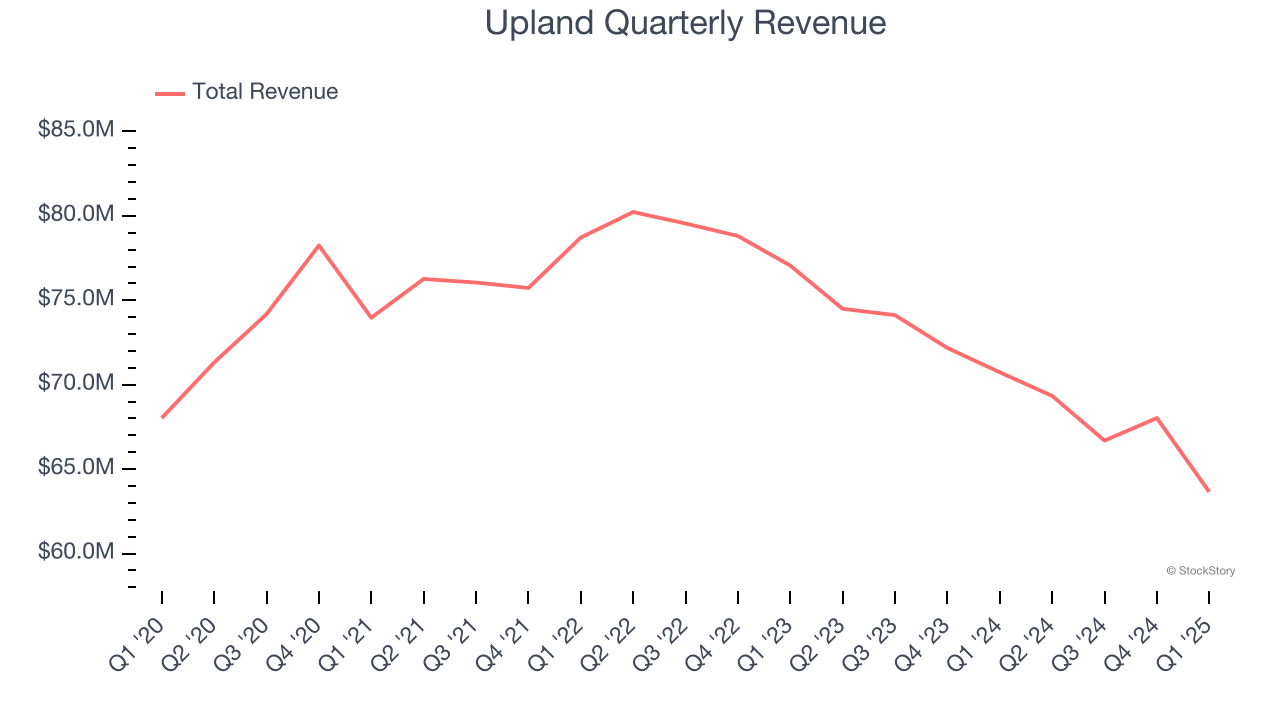
Over the past six months, Upland’s stock price fell to $2.63. Shareholders have lost 19.8% of their capital, disappointing when considering the S&P 500 was flat. This may have investors wondering how to approach the situation.
Is there a buying opportunity in Upland, or does it present a risk to your portfolio? Dive into our full research report to see our analyst team’s opinion, it’s free.
Why Do We Think Upland Will Underperform?
Despite the more favorable entry price, we're swiping left on Upland for now. Here are three reasons why UPLD doesn't excite us and a stock we'd rather own.
1. Revenue Spiraling Downwards
A company’s long-term performance is an indicator of its overall quality. Any business can experience short-term success, but top-performing ones enjoy sustained growth for years. Upland struggled to consistently generate demand over the last three years as its sales dropped at a 4.4% annual rate. This wasn’t a great result and is a sign of poor business quality. 
2. Revenue Projections Show Stormy Skies Ahead
Forecasted revenues by Wall Street analysts signal a company’s potential. Predictions may not always be accurate, but accelerating growth typically boosts valuation multiples and stock prices while slowing growth does the opposite.
Over the next 12 months, sell-side analysts expect Upland’s revenue to drop by 22.7%, a decrease from its 4.4% annualized declines for the past three years. This projection doesn't excite us and suggests its products and services will see some demand headwinds.
3. Long Payback Periods Delay Returns
The customer acquisition cost (CAC) payback period represents the months required to recover the cost of acquiring a new customer. Essentially, it’s the break-even point for sales and marketing investments. A shorter CAC payback period is ideal, as it implies better returns on investment and business scalability.
Upland’s recent customer acquisition efforts haven’t yielded returns as its CAC payback period was negative this quarter, meaning its incremental sales and marketing investments outpaced its revenue. The company’s inefficiency indicates it operates in a highly competitive environment where there is little differentiation between Upland’s products and its peers.
Final Judgment
We see the value of companies addressing major business pain points, but in the case of Upland, we’re out. Following the recent decline, the stock trades at 0.4× forward price-to-sales (or $2.63 per share). While this valuation is optically cheap, the potential downside is huge given its shaky fundamentals. There are more exciting stocks to buy at the moment. We’d suggest looking at our favorite semiconductor picks and shovels play.
High-Quality Stocks for All Market Conditions
Market indices reached historic highs following Donald Trump’s presidential victory in November 2024, but the outlook for 2025 is clouded by new trade policies that could impact business confidence and growth.
While this has caused many investors to adopt a "fearful" wait-and-see approach, we’re leaning into our best ideas that can grow regardless of the political or macroeconomic climate. Take advantage of Mr. Market by checking out our Top 9 Market-Beating Stocks. This is a curated list of our High Quality stocks that have generated a market-beating return of 176% over the last five years.
Stocks that made our list in 2020 include now familiar names such as Nvidia (+1,545% between March 2020 and March 2025) as well as under-the-radar businesses like the once-small-cap company Comfort Systems (+782% five-year return). Find your next big winner with StockStory today.
